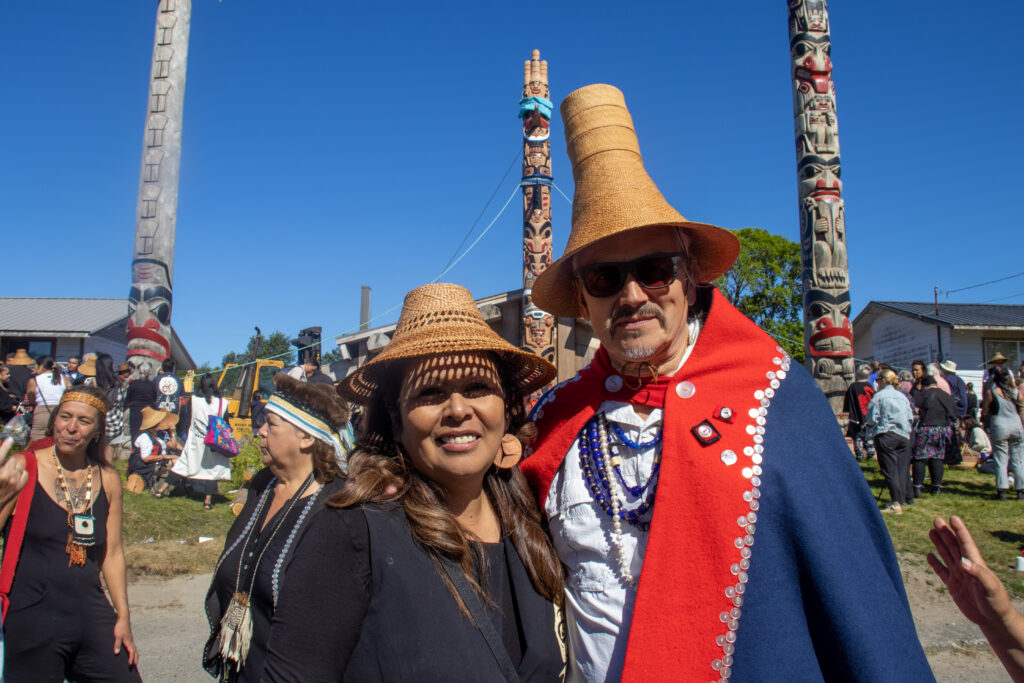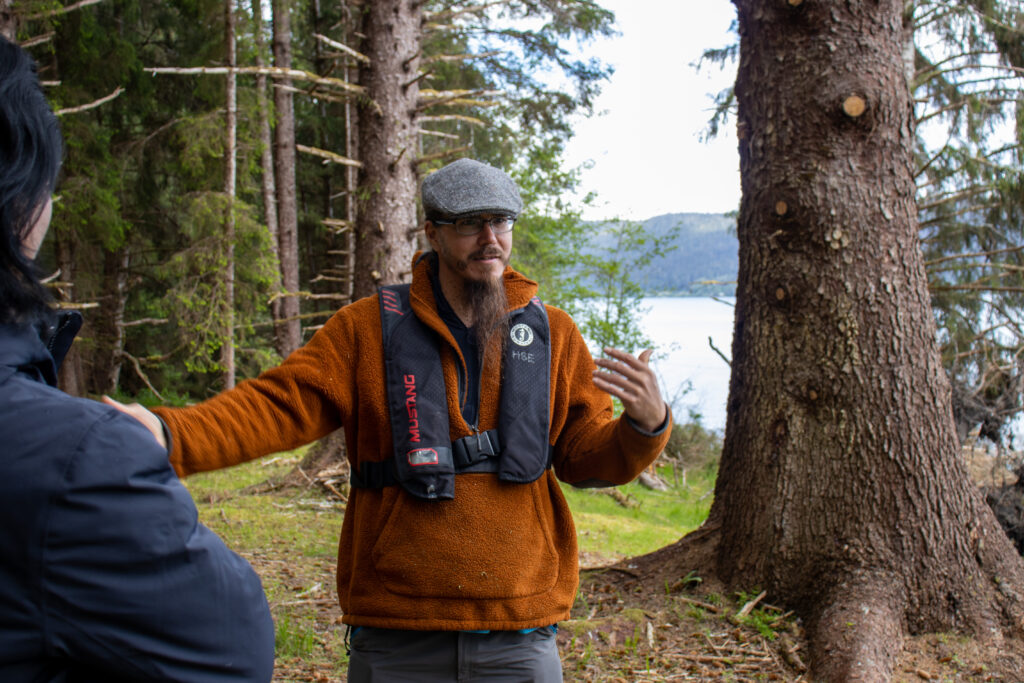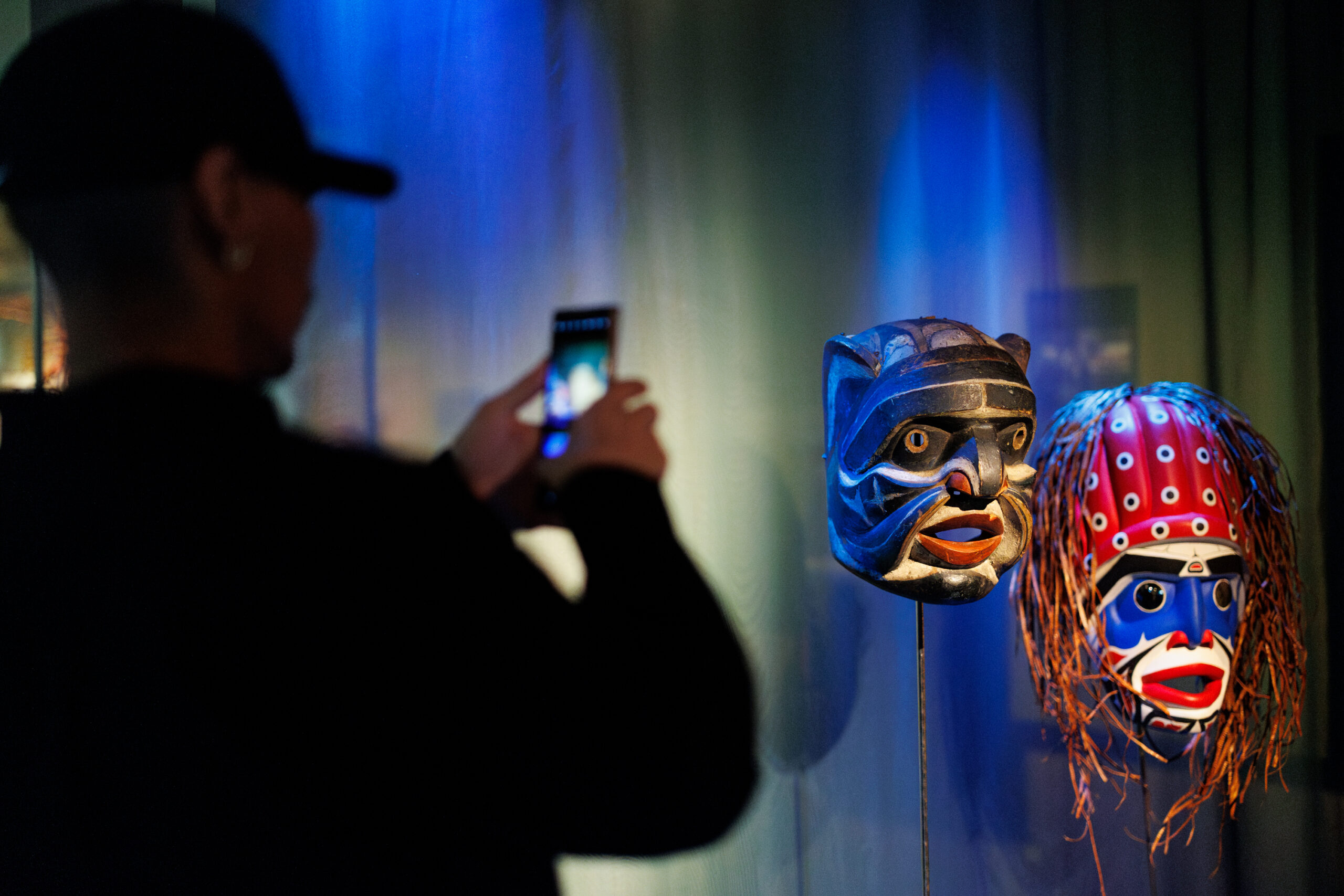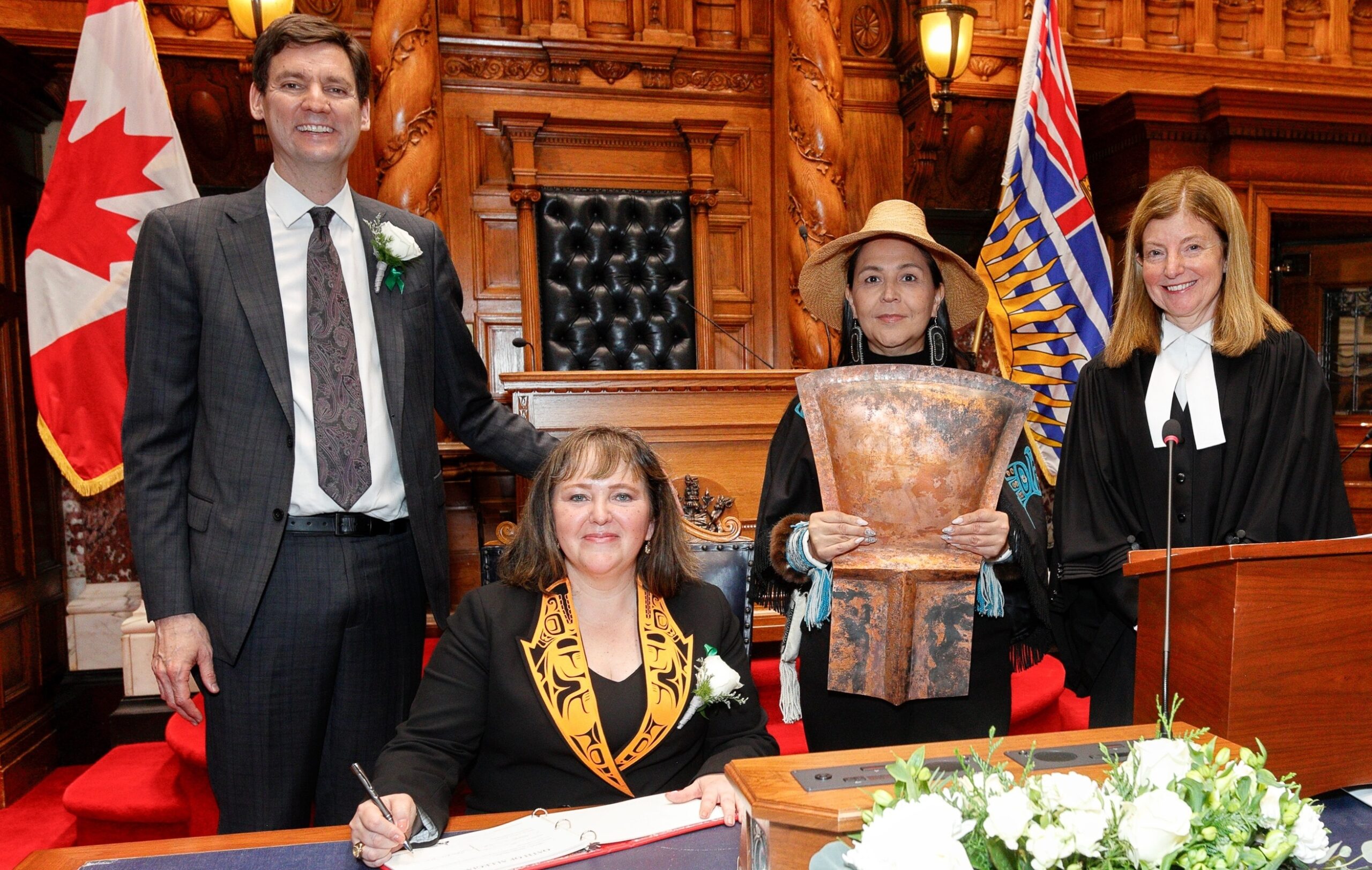While a group of people settle in on a quiet evening to share food and story, a violent and insufferable war wages back in the homelands of members of the delegation. The visitors waited many years to make the long trip from Myanmar to Haida Gwaii, to visit with people who fought for the peace they now offer as a safe haven to the guests.
After introductions, members of the visiting group began to speak about the current state of their homelands, of how villages are being bombed, burned, or flooded with people trying to escape the military after a violent coup in 2021. They spoke of innocent people, women and children, who at this moment are facing horrific atrocities while the international community remains silent.
The guests said they aren’t Burmese or Myanmarese, but Indigenous peoples from different regions and Nations (Karen, Pa’oh, Kachin, Karenni, Mon, Naga, Chin) and their fight isn’t just against the “fascist military,” but for their own rightful recognition as place-based Indigenous peoples with inherited rights and ancestral relationships to their environments. They came to Canada to learn about First Nations’ fight for rights, recognition and self-determination, they said, like the Haida, whom many were first introduced to from a trip hereditary Chief Gidandsa Guujaaw made in 2019.
“In Burma, they kicked out the British after the war — the Japanese came and kicked them out, then the Burmese army wouldn’t let the British back in, but the military stepped in and they spent the rest of their career fighting their own people. It seems that’s what they’re still doing, flooding and dropping bombs on villages,” said Guujaaw. He was joined at the table by hereditary Chief Gaathlaay, President of the Council of the Haida Nation Gaagwiis Jason Alsop and Chief Executive Officer of Coastal First Nations (CFN) Xaad Xyaalaa Christine Smith-Martin.
“While we’re worlds away, there are more parallels than we would think. I’m happy to see all these guys safe and sound… they’re getting brutalized over there right now. A lot of people have fled, thousands and thousands have left the country, but some can’t get out. Like any of us people, they just want peace.”

‘It’s About Survival For Life. We Also Want Recognition.’
The delegation was composed of 13 people from different ethnic nationality areas around Myanmar. Many are working with their ethnic organizations to define their customary land rights, within their specific lands, and to have those recognized. One Co-Chairperson of the All Burma Indigenous Peoples Alliance (ABIPA) who is Naga, said his people like to say they’re “from a place where we say only good friends or serious enemies would reach, it’s very difficult to get to.”
“First of all, thank you very much to the Haida Nation and also the Council of the Haida Nation and also friends of Guujaaw, for receiving us and giving us a lot of background, history, about your beautiful culture of your people and your country,” said the ABIPA Co-Chair during the first dinner of the group’s visit on Haida Gwaii.
In the context of the Haida Nation, we would like to learn about the success stories from your country. We want to hear about your strategies and tools you used. We also want to have recognition and a place where we can exercise our rights as Indigenous people. Our visit here is not just for a few of us, but for our people back home.
During the second day of the group’s visit to Haida Gwaii, a local Haida-owned and operated cultural adventure and fishing expeditions company Haida Style Expeditions took the group to a nearby Haida village of Xaayna and out to the west coast. While the visit gave the group a break from the stress of the ongoing conflicts at home, it was also a chance to share stories and around their own struggles for liberation.
To speak about the situation of Indigenous Peoples in Myanmar, the Naga Co-Chair said, it can be discussed in two parts, “before the coup, and post coup.” When a new government came into power in Myanmar in 2016, Indigenous communities, who have been managing their customary lands for decades, were hoping their rights would be recognized by the new government, but quickly realized that wouldn’t be the case. When the coup occurred in 2021, everything went “back to the military era.”
“When it comes to the status of the Indigenous rights in Myanmar, it’s always neglected. It’s not recognized. Whatever government comes in power, they don’t really recognize Indigenous rights — forget Indigenous rights, they don’t even like to hear the word Indigenous. Post coup, there’s a huge problem with armed conflicts happening across the country, but in Indigenous territories, it’s more severe,” the Naga Co-Chair said.
“Urban populations (predominantly Burmese Buddhists) that stood against the coup-makers, can’t find refuge in the urban areas, so they’ve fled to Indigenous territories and are using it as their base… they’re bombing, shelling, burning down villages, killing people, innocent people, children and women… They’re a fascist military and it’s happening on a daily basis. It isn’t just about claiming their rights, struggling for rights, it’s about their survival for life. We are now under brutal military guise, so the situation now is extraordinary. That’s what we’re seeing.”
The other Co-Chair of ABIPA from the Karen areas in the Tanintharyi Region, works for human rights and environmental issues, develops forest policy for people, promotes Indigenous knowledge and culture, and networks with different groups.
“We Indigenous Peoples in Burma are marginalized by several generations of the regime. We never have rights to manage our own resources. Our area has become a fighting zone,” said the Karen Co-Chair.
An important part of this trip is to learn how Indigenous People in my country can reclaim their ancestral rights.
“In our situation right now, we have to face government policies. Our Karen and Kachin people fought with the British alliance, against the Japanese in the Second World War. Then before independence, there were Burman politicians trying to put us all together as one country. They initiated an agreement, but not all groups signed. We wanted to have our own sovereign State, our own territories. After independence, we faced all kinds of policies, we like to call it ‘Burmatization.’ Trying to destroy our cultures, all our resources, to be under the central control of the Burman dominant group,” explained the Karen Co-Chair.
“Soon after independence, people took arms against the government, because of our rights not being recognized. All around the country we had a civil war against the government. Since 1962 there was a military coup, then another, now I don’t know how many military coups we’ve had, but we are definitely under the dictatorship for more than 70 years.”
One of the Karen Co-Chair’s main concerns is for the young people inside Myanmar, many of whom he sees have “lost their dreams, their hopes.”
“Until now, there’s no school, no University. Young people would like to become like other democratic societies, in terms of freedom of speech, freedom of expression, but at this moment, they can do nothing. Whatever you do against the government, you will be put in jail. It’s a crucial situation in our country. We are trying to find a way to be recognized and regain our rights to manage and govern our territory. After the big storm there will be calm.”
Holding on to Hope
Gabrielle Kissinger works with Forest Trends and supports ABIPA. She played a key role in helping the delegation realize the visit, which has been years in the making. She grew up in L.A. and started coming to Haida Gwaii as a kid in the 1970s. She worked on the Great Bear Rainforest agreements in the 2000s and first started going to Mynamar in 2015 to “see what communities were doing to define their interests in a future democracy,” she said, which is when she started seeing parallels in people’s struggles for their rights, recognition and justice.
“Some of these communities are actually being bombed by the military right now. Communities have been fleeing, hundreds of thousands of people fleeing over the border to Thailand. Over decades, these communities have been forced out by military patrols, forced off their lands, ancestral lands. It’s a very complicated process of overcoming brutality, that’s happening at a scale that’s hard for us to fathom,” said Kissinger.
People are stressed, they’re fearful, they’re desperate, and at the same time, these are some of the most resilient people, because they’re still able to maintain a sense of community and hope, trying to find solutions in the face of it all.
One of the main reasons for a lack of media coverage on the ongoing conflict, is that international media can’t get into Myanmar or into these regions to report on what’s taking place, Kissinger explained.
“It’s very risky. A few journalists were arrested and put into prison and what the military was making clear was ‘don’t report on what’s happening here,’ so that sort of crackdown has meant international news outlets have a hard time covering the story,” she said. “It’s also challenging for those crossing into Thailand. Thailand doesn’t want a lot of refugees in their country so people trying to escape the aerial bombing and fighting need to be careful not to raise too much awareness of the fact they’ve relocated.”
The story of struggle surviving and resisting the “long-standing military dictatorship” for Indigenous communities is a complicated one, she added. It’s hard even for people who have worked for many years around the conflicts, to understand all the different dimensions. Ethnic organizations trying to fight the military have been branded as terrorist organizations, she said.
“They’re not. They’re just trying to resist this terrible military. There’s nuance to the story that doesn’t play easily into international media. These communities are trying to live their lives, raise their food, raise their children, retain their culture. Those stories haven’t gotten out, because international media, if there’s a story to cover, it’s on the military dynamic and the political issues, they don’t come down to these community issues.”
Kissinger said the delegation was intent on learning about how the Haida Nation has built up their governance system, developed different departments, authorities, management actions that interact with the provincial and federal governments Nation-to-Nation. They were also intent on learning about CFN as a traditional and formal alliance, understanding how different Nations have worked together to find alignment and further collective political, legal and social advocacy.
“They’re getting pressure from all sides for the resources. The military and powerful elites are very much wanting to push economic extractive activities and create laws that take power away from these Indigenous communities,” Kissinger shared. “So they face the same types of difficulties really. And we’re here to discuss how despite all of that, to create a razor focus on what inherent land title means, what sovereignty means, and how to advance that.”

Communities Working Together
Haida hereditary Chief Gidandsa Guujaaw, hereditary chief Gaahlaay Lonnie Young, President of the Council of the Haida Nation Gaagwiis Jason Alsop and CFN CEO Xaad Xyaalaa Christine Smith-Martin listened to the guests introduced themselves and share about the struggles their facing.
“These guys have been through real stuff. There is real nasty stuff going on over there that’s not in the eyes of anybody,” Guujaaw told the group. Some people are just filthy rich and still it’s not enough… they want to keep the trees pumping out of there and clear the land and resources… It’s a pretty amazing story, one of tragedy and resilience. While we’re worlds away, there are more parallels than we think.”
Guujaaw, Gaagwiis and Martin shared their own experiences standing up against resource extraction and oppressive foreign government policies. Martin spoke about her Lax Kw’alaams’s community fight to protect their salmon estuary from a big LNG facility and her Haida’s stand to protect Lyell Island.
“We were fighting a multi-billion dollar corporation. We were followed by police constantly, but we didn’t waver, because we knew we had rights and title to those territories and we didn’t give in… Canada was one of the last countries to adopt the United Nations Declaration on the Rights of Indigenous Peoples (UNDRIP), and now today in B.C. here, we’re probably more advanced in UNDRIP than any other province in Canada. And that didn’t happen by accident. It was our people that pushed the envelope. I remember when I was a child when they stood to protect Lyell Island, and I was so proud to see us finding our voice,” Martin shared.
It wasn’t easy. We had our Elders on the line that were arrested. But it had a ripple effect all over BC, all over the country.

Stronger Together
Gaagwiis also recognized the people who came before him, fighting for the rights he and others enjoy and work to protect today.
“I’ve been lucky to be a part of some of the calm, others were a part of the storm. I didn’t have to do as much of the fighting. Our grandmothers and grandfathers and others did that. But they set up what we can take and go forward with,” Gaagwiis shared. A key part to their success, he said, was to build relationships with neighbouring communities with aligned values and interests in preserving and protecting the island for future generations.
“People see where greed is, where the money goes. It all leaves and who’s benefiting? Then they see that working with us is better than the big governments and companies who are just taking things. All these people before us built these relationships together,” he said. “We went to court and the towns here supported us and said we’re better off making local decisions here with the Haida people that live here than in the capital cities. People who live here should be part of that and we know what’s best.”
Alliances are crucial, he added, built between neighbouring communities who care about the wellbeing of the places they have learned to love, as well as breathing life into traditional alliances between Nations, like those represented at the CFN table.
“We have nine communities working together at CFN. They didn’t start when CFN was formed. They had a traditional alliance, they’ve always worked together. The formation of CFN was a formalization of a legal entity,” Martin added. “My job as CEO is to work with all of our communities, each with their own identity, rights and titles, territories. Our job is to regionally develop pieces like the Great Bear Rainforest agreements, Fish Reconciliation, the PFP Great Bear Sea, those kinds of initiatives.”
Gaagwiis said he learned that one of the things that has strengthened his people’s struggle for jurisdiction and rights recognition and indeed that of all CFN Nations, is “not only disrupting the status quo, but having a plan on what to replace it with.”
Back when the Great Bear Rainforest agreements came into play, CFN member communities were adamant on replacing logging with ecotourism, Martin added. Having a long-term vision for how to shift into and effectively fund and manage an ecosystem-based conservation economy was critical for the success of CFN’s programs, initiatives and negotiations.
“Part of the protection work that we’re doing is meeting with some of the stakeholders in our communities that are fishermen, commercial fishermen, sports fishermen, being able to talk about this work we’re doing, but being very clear that at the end of the day, it’s our government and communities have that decision-making authority. It’s driven by our Guardians’ programs, our stewardship offices, our research and databases.”

Different Place, Similar Journey
Stella Naw, a Kachin political activist, from Northern Burma, bordering China and India. She’s now living and working in Ontario. She said she’s been working with the delegation, many of whom are land rights activists, individually and organizationally with APIBA.
Stella traveled to Canada in 2010 and studied Indigenous histories in the North American context. The more she learned about the stories of other Indigenous Peoples, the more she related to their experiences and found a sense of hope for her own people.
“Growing up as Kachin, we got to speak our language at home, but everything else was Burmese. You’re a minority, different from the dominant race, the state official language and religion, and when you go to school or public spaces, you’re constantly reminded that you don’t belong,” Stella said. “The more I got to learn about the history of Indigenous People in Canada or the US, the more familiar it sounded. Why do I know this? I reflected on my entire life, the history of our people, what we were going through in Burma through the State domination and oppression, the forced assimilation and conversion into Christianity, the trauma. I realized there was a big hole in my heart, in my soul.”
Stella said the forced disconnection from their culture and ways was part of the reason so many people were struggling today.
“My grandmother’s younger sister had seven boys and all except one died from drug and alcohol abuse. Before I left for Canada, I knew something was really wrong, but I didn’t exactly know why,” she said. “Getting a chance to study the struggles of communities here really hit me. It’s a different political social situation from where we are in Burma, but it’s a similar journey.”
Stella said she can feel depressed and hopeless, acknowledging the tens of thousands of people who are being put behind bars for opposing the military dictatorship, or the thousands being killed, while there is little to no coverage of the conflicts nationally or internationally. But when she learns more about how other Indigenous Peoples have survived and “picked themselves up with what was left and rebuilt their cultures and Nations,” she feels a renewed sense of hope.
The group enjoyed a full week visiting on Haida Gwaii, getting out on the land and waters, visiting with leaders and community members, attending a highscool graduate ceremony where they witnessed the cultural strength and pride they hope stays ignited in their youth back home. Members of the delegation have since made their way safely back to their homes where their work continues.
“We may be in different political settings and situations, but people here have done and rebuilt so much for themselves and have shown us that we can too,” Stella said.
For more information, read:
Allow Myanmar ethnic groups to manage their own land, Thomson Reuters Foundation News, February 15 (2021)
Is UNESCO overreaching in Myanmar?, Asia Times, September 3 (2017)
They Call It a Crime: Being Born Non-Bamar in a Conflict Zone, The Irrawaddy, March 8 (2017)
The Peace That We Envision, Stella Naw, October 12 (2015)


